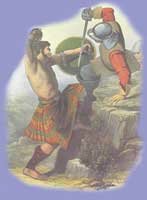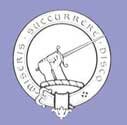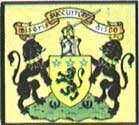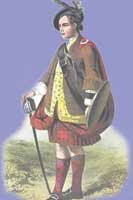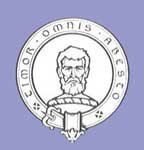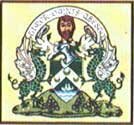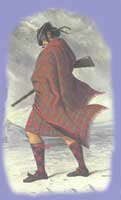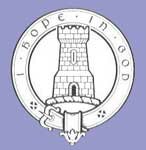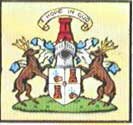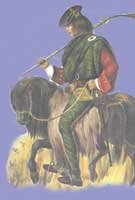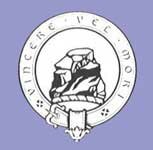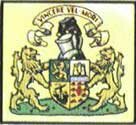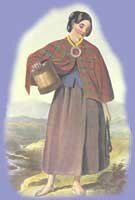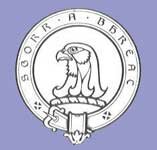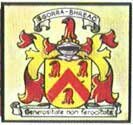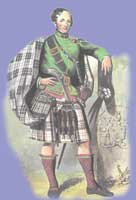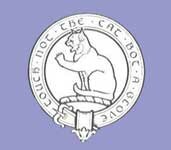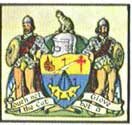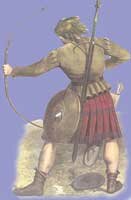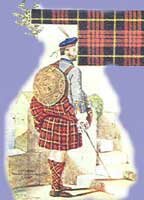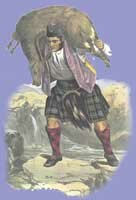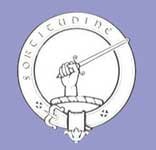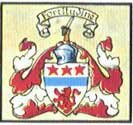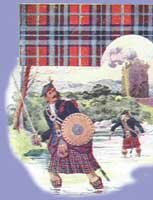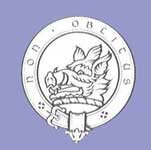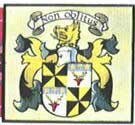Click below to find other Scottish Clans
|
|
|
|
|
Macmillan in Gaelic is spelt; MacGhillemhaoil Meaning (son of the devotee of the tonsured one) it can also be spelt; Maolanach meaning (a tonsured person)
Tonsure is a thing from the Celtic church. It literally means to shave the front of your hair off as opposed to the central cutting of hair by other Priests not of the Celtic Faith. The clan is a descendent of the Celtic Church and from a priest named Cormac who had numerous male children. One of his sons Gillie Chriosd was the originator of the Macmillan Clan and family. David the first abolished the mormaership of Moray and that act allowed the Macmillan's to move into the shores of loch Archaig in Lochaber.
|
|
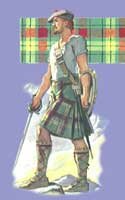 |
The Macmillan Chief Maolmuire sheltered Robert the Bruce the great Scottish hero when he was on the run in the Highlands . He aided him by letting him stay at Ben Lawers which was the Chiefs home. The Macmillan clan fought at the Battle of Bannockburn on the twenty sixth of June 1314 when The Bruce defeated a superior sized English army led by Edward the second.
Around the year of 1360 the Lord of the Isles granted the Macmillan clan, lands at Knapdale. These lands were given with the words: �So long as the wave beats on the rocks �
|
|
The twelfth Chief of the clan Alexander of Knap left two very interesting and enduring Macmillan memorials, the round tower near to Castle Sween known as Macmillan's tower and a remarkable Celtic cross in the churchyard of Kilmore, which is also the Clans burial ground. The cross has the legend inscribed in Latin
� This is the cross of Alexander Macmillan�
The Knapdale line became extinct in 1742 and the successor was from the other branch of the Macmillan's. The Chieftainship was passed to Macmillan of Dunmore. This Chiefs land lay on the side of Loch Tarbert.
John Macmillan refused to join the Jacobite struggle for justice in 1745 unless the Stuart family would renounce their Roman Catholic Faith. His sons however defied him. They recruited some men and went with Locheils Company to fight at Culloden. Both the brothers died in the fierce battle, one from grapeshot wounds and the other from a musket shot. After the Culloden battle Cumberland promised Donald Macmillan of Tulloch that he would be promised protection but he could not be trusted and the Chief and his men were transported to the Caribbean without trial. The Chieftainship suffered badly after that and things were not put right until the present day. In the late twentieth century Sir Gordon Macmillan of Macmillan was recognised by the Lyon Court and established his seat at Finlaystone House in Renfrewshire.
|
|
Chief: Macmillan of Macmillan
Clan Seat: Knapdale, Finlaystone House, Renfrewshire
Plant: Holly
Memorials: Resby-cnaip
|
|
|
| Back to Top |
|
The Macnab name derives from the Gaelic and means �child of the Abbot'
�Mac An Aba '. The clan is of Celtic origin and according to popular tradition the progenitor of this great clan was the Abbot of Glendochart and Strathearn. He was younger son of the famous King Kenneth Macalpin, Abaruadh. The �red Abbot' as he was called was descended from a nephew of Saint Fillan founder of the monastery in Glendochart, this all happened in the seventh century .Angus Macnab joined with the MacDougalls in opposition to Robert the Bruce because Bruce had slain his brother-in-law John, the Red Comyn in the year 1306. Bruce reaped his revenge once he had destroyed Edward the seconds' English army on the twenty fourth of June 1314 at the battle of Bannockburn .
|
|
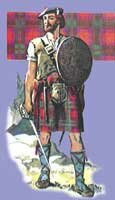 |
Bruce saw his power base totally consolidated practically over night and was quick to extract revenge on his enemies. Angus Macnab was dispossessed and his lands and charters made forfeit. There was better tidings for the family Macnab in the future 1336 saw Gilbert Macnab ( Angus' Grandson) receive charters from King David the second.
When James the fourth was the reigning monarch the Macnabs had a fearsome battle with their most hated enemy the Neishes. The Macnabs won the battle and the Neishes took shelter on the island in Loch Earn. In James the sixths reign the Macnabs commanded by Smooth John and his twelve sons stole onto the island and slew the Neishes except for one man and a boy.
|
|
In 1645/46, the Macnabs were involved in the defence of Kincardine Castle . They also cut a swath through Sir John Middleton's Guards unit, and fought for Montrose at the battle of Kilsyth. John Macnab was captured and sentenced to death for helping Charles the firsts cause. He somehow managed to escape on the eve of his execution. The Clan Macnab was involved in the Battle of Worcester in support of Charles the first in 1651, John Macnab of that Ilk fell that day. In the year 1654 the Laird of Glenorchy assisted �in putting the haill MaKnabs out of this country'
The Macnab chief's family fought for the Hanoverians during the Jacobite struggle of 1745, but his clan fought for the Stuarts. Archibald the thirteenth laird of Macnab sold of his estates and with several hundred of his kinsfolk emigrated to Canada . Archibald himself died in France in1860.In 1957 the Lyon Court adjudged that Archibald Macnab of Arthurstone to be the Macnab of Macnab. He in turn was succeeded by his nephew James Charles Macnab of Macnab In 1970.
|
|
Chief: Macnab of Macnab
Clan Seat : Kinell, Killin, Perthshire, Bovan, Perthshire
Plant: Stone Bramble Memorials : Innis Buie
|
|
| Back to Top |
|
The Clan MacNaughten came from along the shore of loch Awe in Lorn and is Celtic in origin. Their progenitor was a Pictish King named Nechtan or Nechtan. This ancient King founded Abair Neachtain or Abernethy. He also founded a church at the Abby on the head of Loch Fyne in about 1246. Gilchrist MacNaughten was granted the custody of a Castle and the island of Fraoch Eilean in Loch Awe, Lorn by Alexander the third in the year 1267. The MacNaughten was one of the magnates of that ancient Gaelic society. Part of this charter was the assurance that the MacNaughten clan would guard the narrow pass of Brander which is the gateway to the western Highlands .
The MacNaughten was one of the twelve men who would give their lands to be formed into the new Sheriffdom of Argyll.
|
|
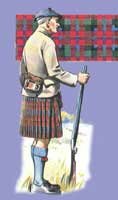 |
Like their kinsmen the MacDougalls of Lorne and the Comyn from the north, the MacNaughtens and their Chief Donald opposed Robert the Bruce. The clan paid dearly for this mistake when The Bruce broke the English yoke by defeating Edward the second at the Battle of Bannockburn 24th of June 1314. Bruce ruthlessly took away their lands and passed them to the Campbell Clan who had supported him. Some of these lands were returned at a later date when the MacNaughten Clan supported Robert the Bruces son David the second.
Donald MacNaughten became Bishop-elect of Dunkeld in 1426. Sir Alexander MacNaughten of the Ilk fought at the battle of Flodden in 1513 and died with the man who had Knighted him King James the fourth.
|
|
Another Alexander MacNaughten was to raise a magnificent band of archers in support of Charles the first and fought throughout his campaign with him. He also fought for Charles the second and at Killiecrankie in 1689. For this he was punished with the loss of his estates.
The clan had split up with some moving to Antrim in Northern Ireland in 1580. The last Chief of the direct line had got into bother with his prospective father in law and had also flown away to Antrim in Northern Ireland . When the Chief left his lands he lost what was left of his clan's rights.
The chieftainship remained dormant until the nineteenth century when a remarkable demonstration was made by about four hundred members of the MacNaughten clan. When Sir Alexander MacNaughten had been killed at Flodden it was not realised that the title should have descended to a young son who had emigrated to Antrim. After much ado it was finally agreed upon as to who was indeed the rightful Chieftain of the clan MacNaughten, The Clan is now represented by Sir Francis MacNaughten of Dunerave who is the eighth Baronet.
|
|
Chief: MacNaughten of Dunderawe
Clan Seat: Dunderawe Castle (Castle of the Two Oars), Argyll
Plant: Trailing Azalea
Memorials: None
|
|
| Back to Top |
CLAN MACNEIL OF BARRA / GIGHA
|
| These two Clans are so associated with each other it is hard to tell them apart. Their history is similar and dated from the same time and place in Scottish affairs. The MacNeils of Barra and the MacNeils of Gigha are both of Celtic origin, and Gigha is reckoned eldest cadet of Barra. The two families are descended from the Irish High King �Neil of the Nine Hostages� Who was the founder of the amazing fifth century O'Neil dynasty. The clans first settled in this area of Scotland in the eleventh century. An early charter is mentioned in 1427 and was given to a MacNeil of Barra named Gilleonan. The charter also included Boisdale in neighbouring South Uist. The charter had come from the Lord of the Isles. |
|
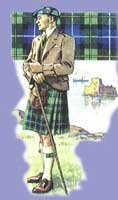 |
Gilleonan is on record as being the ninth Chief of Barra in 1545 at the same time the Chief of Gigha was Neil MacNeil. His son Neil went on to become the originator of the MacNeil clan at Taynish. The branch clan on Gigha changed when James MacDonald bought the island in the year of 1554, it changed hands again and in 1590 was acquired by hector MacNeil of Taynish.
Barra was lost to the MacNeils when one of their kinsmen was accused by Elizabeth the first of seizing an English ship. The named man was Roderick MacNeil but he escaped only to be caught by MacKenzie of Kintail.
|
|
He was found guilty and Barra was given to MacKenzie as forfeit. The island then passed to Sir James MacDonald of Sleat until 1668. Later that same year Roderick MacNeil of Barra obtained a Crown charter for the island making it a free barony.
Several MacNeils with the Christian name of Roderick succeeded. Barra was sold in 1840 to Colonel John Gordon of Cluny . After many years of wrangling Robert Lister MacNeil the twenty-fifth Chief recovered the island of Barra and Kismull Castle , the island fortress, for the MacNeil Clans people.
From the Gigha connection came many other branches of the MacNeil Clan. In addition to the Taynish family there were branches in Gallachoille, Caraskey, and Tir Fergus.
The Children of the MacNeil house were according to old Highland custom�Taught their genealogy on Sunday mornings�
|
|
Chief: The MacNeil of Barra
Clan Seat: Kismull Castle , Isle of Barra, Isle of Gigha and Colonsay
Plant: Dryas
Memorial: None
|
|
| Back to Top |
CLAN MACNICOL OR NICOLSON
|
|
The name MacNicol and Nicolson are another enigma of the Clans. Where did they come from, is the question most frequently asked by history? There are two strong possibilities as to the origin of this Clan. Firstly they were definitely of old Nordic stock and it is known that MacNicols were settled in Skye in the middle of the eleventh century. In the year 1263 at the battle of Largs Sir Andrew Nicolson who was a Danish Knight from the Isle of Skye , commanded one of Hacos ships.
So which branch of the tree did the Clan MacNicol or Nicolson come from? Gaelic Genealogy and tradition give one branch of MacNicols or Nicolsons is given an extremely ancient past, it is said that a MacNicol from Portree was a member of the Council of sixteen who were responsible for the Lordship of the Isles before it was abolished in 1493. A history of the MacDonalds written in the reign of Charles the second makes mention of MacNicol of Portree.
|
|
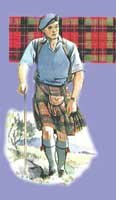 |
Another great tradition tells that the MacNicols or Nicolsons lived at the very tip of Northern Scotland near Durness and Cape Wrath . It was said that their ownership was passed on when a MacNicol heiress married a Macleod of Lewis. Whatever the true history of the clan, there is no doubt that in 1507 the name Nicolson and MacNicol was recorded on the island of Skye and the Chieftain line was established there at Scorrybrec(k). Members of the MacNicol Nicolson family settled in different parts of Skye, Lonfeaon, and Penefiler Aird being a few of them.
After the collapse of the Lordship of the isles the clan followed the MacDonalds and fought alongside them in the civil war of the seventeenth century.
|
|
The MacDonalds of Sleat were Jacobite sympathisers and had fought in 1715 but had been severally punished for this by forfeit. So were not so keen in the struggle of 1745 but a band of Nicolsons and MacLeods of Raasay joined the Stuarts of Appin to fight at the Battle of Culloden in 1746. Because of the upheaval caused by Cumberland during and after the Highland clearances, Norman Nicolson the Clan Chief was forced to leave Scorrybrec(k) and emigrate to New Zealand . A member of the Nicolson family went on to be famous for his work in the Celtic field (collection of Gaelic poems) he was also and Advocate and had been called to the bar in 1860. His name was Alexander Nicolson who had been born at Hugobost in Skye in the year 1827. He was also commissioned to report on the state of Highland education system. Lord Napier made him part of his team to inquire into conditions of the crofters in 1883. The present day Chief Nicolson of Scorrybrec(k) lives in Canberra Australia .
|
|
Chief: Nicolson of Scorrybrec
Clan Seat: Scorrybrec House, Skye
Plant: None
Memorials: Snizort in Skye
|
|
| Back to Top |
| The name MacPherson is of course derived from the Gaelic ' Mac-a Phearsain' it means in English � son of the parson' There are two main branches to this great clan, the MacPhersons from Invershie and the others from Ballindalloch. The Clan of course finds its roots are Celtic in origin. Duncan the parson was from Strathnairn and this branch is called � Sliochd Gillies' but the clan themselves are dated as from 1309 when it is said that Robert the Bruce the great historical Scottish King proposed granting the lands of Badenoch to the chief of the MacPhersons on condition that he destroyed Bruces bitter enemy the Comyns. It is assumed that the Chief in command was Ewan Ban MacMhirich. This Chief had three sons and they duly carried out the kings wishes with alacrity. The three sons were: Kenneth of Clunie, Iain of Pitmain and Gillies of Invershie. The MacPhersons are sometimes known by the name of � The Clan of the Three Brothers' |
|
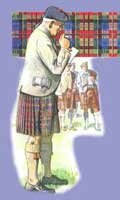 |
Duncan the parson formed the MacPhersons as they are now known in the year 1438.
For many years the Clan would challenge for the right to lead the great Clan Chattan. The eighth Chief Andrew MacPherson acquired the Abbey-Castle grange at Strathisla in the year 1618. He had a son Euan who turned out to be a magnificent warrior and royalist. He fought for Montrose in support of King Charles the first during the civil war. The MacPherson clan lost out on another attempt to lead Clan Chattan when the Privy Council and the Lord Lyon King of Arms ruled against them and the great honour went to a Mackintosh.
|
|
Another Euan of Cluny became a famous Highland leader in the Jacobite struggle of 1745. He fought and defeated a vastly numerically superior force at Westmorland while on the retreat from Derby . After the Battle of Culloden and the atrocities carried out by Cumberland 's soldiers there was a £1,000 reward put on Euans head which was never claimed. Nine years later he managed to escape to France in 1755.
William MacPherson the purser fell at the battle of Falkirk in 1746 and in the same year his nephew James MacPherson of Balavil witnessed the burning of Cluny castle by Cumberland 's brutal Government troops.
In 1784 the MacPherson estates were returned to them and accepted by � Duncan of the kiln' MacPherson Chief. He was called this unusual name because his mother had been in hiding at the time of his birth. Duncan was indeed born in an old corn kiln. His son Ewan succeeded and went on to lead the clan till his death in 1885.
Another Duncan MacPherson led the Black Watch over the trenches at Tel-el-Keber.
|
|
Chief: MacPherson of Cluny ( Cluny MacPherson)
Clan Seat: Cluny in-Badenoch, Kingussie
Plant: White heather
Memorials : None
|
|
| Back to Top |
|
The Lord of the Isles awarded a charter to the Macquarrie family clan in 1463. It was witnessed by one John Macquarrie who was in possession of Ulva and part of Mull . He died about 1473 and is the first Macquarrie chief to be prominently mentioned. When the lord of the isles was forced into forfeiture the Macquarrie clan decided to follow the Macleans of Duart. MacGorry of Ullowaa was summoned for rebelling with Donald Dubh who claimed the Lordship of the Isles in the year 1504.
In the year 1609 King James the first summoned all the Highland Chiefs to attend the sermon of a Bishop. When they were all in attendance he had them kidnapped and held until they signed the document the Statutes of Iona which virtually took away all their power on the islands.
|
|
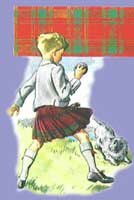 |
Macquarrie of Ulva was among the Chiefs taken in by the devious movements of the Stewart monarch. They submitted to Andrew Knox Bishop of the isles and the Kings commissioner at Iona Abbey.
The Macquarrie alliance with the Macleans was to cost them dearly in the support of Charles the second in 1651. The Chief of Ulva was killed with many of his men at the battleground of Inverkeithing. Ulva had a visit from the famous pairing Johnson and Boswell in 1773 and found the island to be of no great extent, rough and barren inhabited by the Macquarie 's; �a clan not powerful nor numerous, but of antiquity, which most other families are content to reverence.'
|
|
They must have liked the island as they stayed there for five years until the Chief Lachlan Macquarrie decided to sell the property in 1778. Lauchlan went on to be a soldier again at the ripe old age of 63. Lachlan Macquarrie owned the neighbouring island of Staffa which was to become so famous in the musical world when Mendelssohn wrote about the strange rock foundation popularly known as Fingals Cave .
When the old 74 regiment, Argyll Highlanders was being set up Lachlan Macquarrie (1762-1824) became one of the officers in it. Born on the small island of Ulva he rose through the ranks to become a Major-General and then returned to his native country of Scotland to buy himself property on Mull . The famous Captain Bligh was Governor of New South Wales in Australia and when he was dismissed from the post his successor was Lachlan Macquarrie of Ulva who served there from 1809-1821.
The Lyon Register has Arms registered in the name of Lachlan Macquarrie of New South Wales.
Major-General Lachlan Macquarrie worked hard in his new post and introduced several controversial laws that were mainly aimed at the convict inhabitants of the Australia of that time. He was very Calvinistic in his approach to anything. He built better roads and introduced an educational system. He was later looked upon as one of the � Fathers of Australia �
|
|
Chief: Macquarrie of Ulva
Clan Seat: Isle of Ulva
Plant: Pine Memorials: None
|
|
| Back to Top |
|
Clan Revan is better known as the Macqueens, they originated as a Celtic tribe of ancient Scotland . The Hebrides were their domain, and the founder of the Macqueen clan was said to be Roderick Dhu Revan MacSweyn or Macqueen that was in the fifteenth century. The Macqueens count the clan Donald as kindred people and were related to the famous King Conn of the Hundred Battles in Ireland . Sweyn the Old Norse name (as in Roderick's name) translates into modern day Danish language as the very common Svend.
The Macqueens fought under the standard of mackintosh at the battle of Harlow in 1411. They were known as ferocious fighting men if they believed in the cause.
|
|
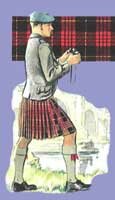 |
There is also a branch of the Macqueen clan in the Findhorn valley. This came about when the tenth mackintosh Chief married a Clanranald bride and a number of the Macqueens accompanied her to make their homes in Strathdearn near Findhorn.
The Clan thrived in the fertile Findhorn valley and became known as Clan Revan, they also became members of the famous Clan Chattan on the fourth of September1609 when their Chief Donald Macqueen of Corrybrough signed the manrent.
|
|
In 1778 Lord MacDonald of Sleat who had now become an Irish peer, conferred a lieutenancy on the sons of Duncan of Corrybrough. In a letter dated in January of that year the Lord of Sleat said this �It does me great honour to have the sons of Chieftains in the regiment, and as the Macqueens have invariably been attached to our family, to whom we believe we owe our existence, I am very proud of the Nomination� The Macqueens also have the reputation for being excellent seamen and they can still be found in large numbers on the island of Scalpay. On the island of Skye the Macqueens held some land and it was indeed the Macqueen family who accompanied the two famous people Johnson and Boswell on their trip there. Johnson described the Reverend Donald Macqueen as the most intelligent man in Skye.
The Macqueen clan in time had to move from their ancient live style and emigrate from the Hebrides across the mighty Atlantic Ocean to America and Canada . Some of them went the other way to the south and the colonies of Australia and New Zealand .
There is another member of the Macqueen family who became famous but for all the wrong reasons. His name was Robert Macqueen Lord Braxfield �The Hanging Judge'
It is only fair to point out that Robert Macqueen came from Lanarkshire and not the islands or clan Revan. The clan Macqueen and the clan MacSweyn although similar have different registrations lodged with and accepted by the Lord Lyon.
|
|
Chief: Not Known
Clan Seat: Corrybrough, Strathdearn, Inverness-shire
Plant: Unknown Memorials: None
|
|
| Back to Top |
|
The MacRaes are another Celtic Clan and in Gaelic their name is spelt MacRath and means �Son of Grace� it has also been Englified to the name Magrath. The clan were well known for their wild ferocious ways and their fighting skills, especially the branch from Kintail in Wester Ross. They were called�The Wild MacRaes� The Macraes had fought at the battle of Largs in 1263.
In 1476 after a famous battle at �Blar-na-pairc' the Mackenzie chief asked why Surachan Macrae had stopped fighting. He was a man of huge stature and had never stopped killing his enemy all day. He explained that he had done enough work for that day, but Mackenzie goaded him to more efforts by saying �Kill more and I shall not count your work by the day' the MacRaes composed a tune for the clan after that fight it is called � Spaidsearachd Mhic Rha� it means � The March of the Clans�
|
|
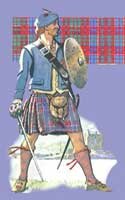 |
They were elected as a barony for the Mackenzie's in the year 1508.
Kintails strong hold is the magnificently impressive ancient castle of Eilean Donan in Loch Duich. The castle is named after a Saint of the Celtic church who was martyred on the island of Eigg . It is also commemorated in Kidonan.
For a very long period the castle was held for the Mackenzie's by the MacRaes, where they became known as �The Mackenzie Shirt of Mail� In the year of 1539 when the MacDonalds recognised Donald of Sleat as Lord of the Isles, they attacked the huge ancient Castle of Eilean Donan in an attempt to control the whole area.
|
|
The MacRaes who were defending it fought them off. Duncan MacRae who was known for his ability with bow and arrow shot the MacDonald Chief of Sleat and he later died from his wounds. Although the Clan were known for their ferocious war-like nature there was another side to them. There was the reverend Farquhar Macrae of Inverinate (1580-1662) who managed to combine his work as Chamberlain of Eilean Donan Castle with his Ministry in Kintail. All together he worked at this for over forty years.
His son John Macrae (1614-1673) of Dingwall on the Black Isle would follow in his footsteps and also become a minister. The world famous Gaelic anthology the Fernaig Manuscript was composed by him.
In 1645 the Clan fought for Montrose at the battle of Auldearn under the �Caber Fey� where they lost a great deal of man power. The MacRae clan were out again in the 1715 Jacobite struggle for justice. They fought with the Earl of Mar at the Battle of Sheriffmuir and lost many men in the fighting. Brigadier General William MacRae (1834-1882) was distinguished by the American Confederate army during the civil war there.
|
|
Chief: MacRath
Clan seat : Inverinate, Inverness-shire
Plant : Club Moss
Memorials: Kintail, Auld Kirk
|
|
| Back to Top |
| This Clan name is first noted and recorded as early as the second half of the eleventh century. MacTavish is the modern spelling for the Clan name. but the name originates from Taus Coir (Tammis) The family really comes about with a man who was married twice the second time to make himself more powerful. His name was Gillespic and he married Sween the red in the eleventh century. He was the Toisech (leader or chief) of his tribe or Clan and they lived in Knapdale. He was a ruthless man and when he saw an opportunity to make things better for himself he duly took it. He got rid of his wife and married another woman who was close to the King. Her father was actually the treasurer to the King of Scots and his name was Paul'an sparain' she was called Eva O'Duin. They had two sons called Taus (Thomas) and Evir. |
|
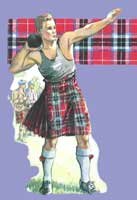 |
Taus became the progenitor of the family Clan MacTamhus which of course became MacTavish and also Thom(p)son from, Son of Taus. His brother Evir was the progenitor of the family Clan Ivor.
They were noted as a Clan of great antiquity by the charters from the twelfth century for both North and South Knapdale . The were known as � The Children of Colla' Perhaps better known as � The Children of the Mist�
|
|
In 1745 during the Jacobite Struggle for truth the MacTavish Clan were very much supporters of the Stuart cause and joined with their Campbell neighbours to secretly put together an army for Prince Charles Edward Stuart (Bonnie Prince Charlie) The Campbell being Sir James of Auchnabreck which was just adjacent to their own home at Dunardarie. Sir James was an anti-Argyll Campbell . Unknown to him he had a spy in his household and the plot was discovered by the Duke of Argyll. He immediately arrested MacTavish but did not interfere with Sir James at that point.
When it came time for the Battle of Culloden the MacTavish family could not get the Clan to raise as their Chief was still in prison but they joined with the Mackintosh Clan and the Frasers. As history will tell us Bonnie prince Charlie was sorely defeated at the Battle of Culloden and Scotland 's hopes of riding there country of the Hanoverians, and putting back in place a true Stuart Monarchy, were put to sleep, for the time being.
In 1796 the MacTavish Clan did not register that they had a new chief and it went on from there until nobody knew who the real chief of the MacTavish Clan was.
In 1997 on the twenty-seventh of July, Dugald MacTavish was matriculated by the Court of the Lord Lyon, and was granted Arms and Title of Chief of the Clan MacTamhais (MacTavish/ Thom(p)son) Dunardry is the twenty-sixth Chief of the Clan in an unbroken line.
|
|
Chief: MacTavish of MacTavish
Clan Seat: Dunardry, Argyll
Plant: None
Memorials: None
|
|
Click below to find other Scottish Clans
|
|
Back to Top
|

